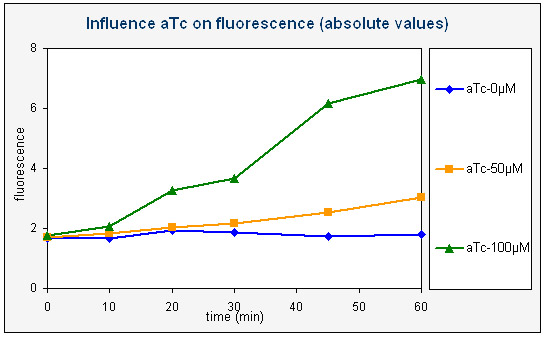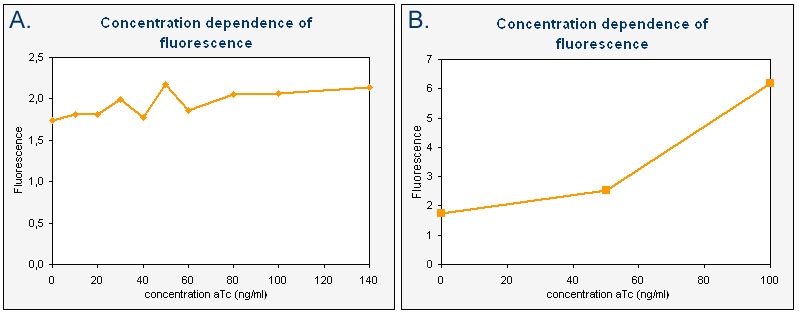Team:KULeuven/Data/Output
From 2008.igem.org
m |
m (typo) |
||
| (3 intermediate revisions not shown) | |||
| Line 1: | Line 1: | ||
| + | {{:Team:KULeuven/Tools/Styling}} | ||
| + | {{:Team:KULeuven/Tools/Scripting}} | ||
{{:Team:KULeuven/Tools/Header}} | {{:Team:KULeuven/Tools/Header}} | ||
| - | + | [[Image:pictogram_output.png|120px|right]] | |
==Output== | ==Output== | ||
| + | |||
| + | [http://partsregistry.org/wiki/index.php?title=Part:BBa_K145205 Parts Registry:K145205] | ||
| + | |||
| + | [http://partsregistry.org/wiki/index.php?title=Part:BBa_K145280 Parts Registry:K145280] | ||
| + | |||
| + | === Introduction === | ||
| + | |||
| + | The output is one of the three modules that is directly connected with the input. In a normal, medical, application the input would be a certain disease marker that leads to the production of a certain drug (output). The amount of drug would then diminish from the moment that the disease marker disappears. However, our Dr. Coli is only a proof of concept and we replaced these specific medical markers with more simple proteins. The input consists of a constitutive TetR generator and the output consists of a GFP under the control of a ''tet'' promoter. This means that the production of GFP is normally repressed by TetR. But when we add anhydrotetracyclin (aTc), TetR will not function and the production of GFP starts. So, the production of GFP is controlled by the presence or absence of aTc. | ||
| + | |||
| + | GFP is used because we can easily detect its fluorescence. However, we would like this fluorescence to closely follow the presence of aTc. This is impossible with wild type GFP because its fluorescence can be detected days after its production ceased. Therefore a GFP with LVA tag was made. This will render GFP susceptible to degradation and the fluorescence will stop shortly after the production of GFP-LVA stops. This way, the fluorescence should nicely follow the input. | ||
| + | |||
| + | To test this system, we built the TetR generator (input) and combined it with the output. By adding or removing aTc to cells containing this construct, we should be able the switch the fluorescence on and off. We tested this by measuring the fluorescence with a ''fluorescence-activated cell sorting'' (FACS) apparatus. | ||
| + | |||
| + | |||
| + | === Materials and methods === | ||
| + | |||
| + | ==== Media ==== | ||
| + | |||
| + | The media used were Luria-Bertani (LB) medium or agar plates. LB medium was used to make liquid cultures (composition on [http://openwetware.org/wiki/LB OWW]). The LB-agar plates were used to plate cells. These media also contained ampicillin (100µg/ml). | ||
| + | |||
| + | ==== Constructing plasmids ==== | ||
| + | |||
| + | The plasmid should contain two major constructs: the input ([http://partsregistry.org/Part:BBa_K145201 K145201]) and the output ([http://partsregistry.org/Part:BBa_K145205 K145205]). The method to obtain the input is described at the data analysis page of the input ([https://2008.igem.org/Team:KULeuven/Data/Input#Constructing_plasmids link]) and the method to obtain the output is described at the data analysis page of GFP-LVA ([https://2008.igem.org/Team:KULeuven/Data/GFP#Constructing_plasmids link]). | ||
| + | |||
| + | When we had these two plasmids, we could start building the test module. Therefore we miniprepped the plasmids containing K145201 and K145205. After that, K145201 was cut with ''Eco''RI and ''Spe''I, and K145205 was cut with ''Eco''RI and ''Xba''I. These two digests were then ligated to each other with T4 DNA ligase. This resulted in a pSB1A2 plasmid containing the BioBrick [http://partsregistry.org/Part:BBa_K145280 K145280]: | ||
| + | {|style="background:#ffffff; text-align:center; width:80%" | ||
| + | |[[image:K145201b.JPG|center]]||+||[[image:K145205.JPG|center]]||=||[[image:K145280b.jpg|center]] | ||
| + | |- | ||
| + | |[http://partsregistry.org/Part:BBa_K145201 K145201]||||[http://partsregistry.org/Part:BBa_K145205 K145205]||||[http://partsregistry.org/Part:BBa_K145280 K145280] | ||
| + | |} | ||
| + | |||
| + | ==== Measuring fluorescence of single cells ==== | ||
| + | |||
| + | The method used to test the output is basically the same as the method used to test the input. Testing the input and the output was therefore done on the same day (parallel with each other). We will not discuss the procedure here, but a similar procedure can be found at the data analysis page of the input, [https://2008.igem.org/Team:KULeuven/Data/Input#Measuring_fluorescence_of_single_cells here] (just substitute K145279 by K145280). | ||
| + | |||
| + | |||
| + | === Results and discussion === | ||
| + | |||
| + | ==== Time dependence ==== | ||
| + | |||
| + | [[Image:Data-output(1).JPG|thumb|right|450px|<div style="align:justify;"> Graph of the fluorescence of GFP-LVA as a function of the time after adding aTc. One can see that adding aTc will lead to more fluorescence, albeit not very much. </div> ]] | ||
| + | |||
| + | We made liquid culture of colonies with K145280, containing 0, 50 and 100 ng/ml anhydrotetracyclin. These cultures were withdrawn after 10, 20, 30, 45 and 60 minutes and the fluorescence was measured with FACS. With CELLQuest<sup>TM</sup> analysis software a histogram of the fluorescence (channel FL1-H) was made and the mean of the fluorescence was calculated. With Excel a plot was made of this average fluorescence as a function of time (see right). These graphs show that adding aTc induces the transcription of GFP-LVA from the ''tet'' promoter. The graphs also show that higher concentrations of aTc result in more fluorescence. However, the increase in fluorescence upon the addition of aTc is not very spectacular. This is probably due to the intrinsic instability of GFP-LVA, which gets degraded from the moment it is produced. To overcome this problem and obtain higher fluorescence yields, one should add quite high concentrations of aTc (140 ng/ml or maybe even more). It is also important to use cultures that are in an early logarithmic growth phase, otherwise the degradation of GFP-LVA will be too strong and the fluorescence yields will be very low (as was the case in our measurements). | ||
| + | |||
| + | ==== Concentration dependence ==== | ||
| + | |||
| + | We made liquid culture of colonies with K145280, containing 0, 10, 20, 30, 40, 50, 60, 80, 100 and 140 ng/ml anhydrotetracyclin. After 3.5 hours the fluorescence was measured with FACS. With CELLQuest<sup>TM</sup> analysis software a histogram of the fluorescence (channel FL1-H) was made and the mean of the fluorescence was calculated. With Excel a plot was made of this average fluorescence as a function of the aTc concentration (see below, graph A). This graph doesn’t really show a nice correlation between the amount of aTc added and the fluorescence measured. This is probably due the fact that the cells were already growing for more than 8 hours. So the cultures were not in an early logarithmic phase anymore and the degradation of GFP-LVA was already important. Therefore we made a second graph (see below, graph B), but this time of the fluorescence after 45 minutes of the samples with 0, 50 and 100 ng/ml aTc. Here we can see an increase of the fluorescence with the concentration of added anhydrotetracyclin. | ||
| + | |||
| + | [[Image:Data-output(2).JPG|thumb|centre|950px|<div style="align:justify;"> Graphs of the absolute fluorescence of GFP as a function of the concentration of aTc. The three colors represent the three colonies with 0, 50 or 100 ng/ml aTc. ''Graph A'' contains the data obtained after a long incubation time with aTc (192 min). ''Graph B'' contains the data obtained after 45 minutes.</div> ]] | ||
| + | |||
| + | ==== Conclusion ==== | ||
| + | |||
| + | We can conclude that the parts K145205 and K145280 behave as expected. TetR is indeed constitutively produced and will therefore switch of the production of GFP-LVA. The addition of aTc can switch on the production of GFP-LVA. Fluorescence yields are quite low however. We think that this can be overcome by using cultures in an early logarithmic growth phase or by using high aTc concentrations. Another way to obtain a higher yield would be to change the ribosome binding sites in the construct, e.g. use a weaker RBS to translate the Tet repressor or a stronger one to translate GFP-LVA, or to change the promoter in the TetR generator. This way you can alter the concentrations of TetR and GFP-LVA and you would be able to obtain higher fluorescence yields. | ||
Latest revision as of 23:16, 27 October 2008
Contents |
Output
[http://partsregistry.org/wiki/index.php?title=Part:BBa_K145205 Parts Registry:K145205]
[http://partsregistry.org/wiki/index.php?title=Part:BBa_K145280 Parts Registry:K145280]
Introduction
The output is one of the three modules that is directly connected with the input. In a normal, medical, application the input would be a certain disease marker that leads to the production of a certain drug (output). The amount of drug would then diminish from the moment that the disease marker disappears. However, our Dr. Coli is only a proof of concept and we replaced these specific medical markers with more simple proteins. The input consists of a constitutive TetR generator and the output consists of a GFP under the control of a tet promoter. This means that the production of GFP is normally repressed by TetR. But when we add anhydrotetracyclin (aTc), TetR will not function and the production of GFP starts. So, the production of GFP is controlled by the presence or absence of aTc.
GFP is used because we can easily detect its fluorescence. However, we would like this fluorescence to closely follow the presence of aTc. This is impossible with wild type GFP because its fluorescence can be detected days after its production ceased. Therefore a GFP with LVA tag was made. This will render GFP susceptible to degradation and the fluorescence will stop shortly after the production of GFP-LVA stops. This way, the fluorescence should nicely follow the input.
To test this system, we built the TetR generator (input) and combined it with the output. By adding or removing aTc to cells containing this construct, we should be able the switch the fluorescence on and off. We tested this by measuring the fluorescence with a fluorescence-activated cell sorting (FACS) apparatus.
Materials and methods
Media
The media used were Luria-Bertani (LB) medium or agar plates. LB medium was used to make liquid cultures (composition on [http://openwetware.org/wiki/LB OWW]). The LB-agar plates were used to plate cells. These media also contained ampicillin (100µg/ml).
Constructing plasmids
The plasmid should contain two major constructs: the input ([http://partsregistry.org/Part:BBa_K145201 K145201]) and the output ([http://partsregistry.org/Part:BBa_K145205 K145205]). The method to obtain the input is described at the data analysis page of the input (link) and the method to obtain the output is described at the data analysis page of GFP-LVA (link).
When we had these two plasmids, we could start building the test module. Therefore we miniprepped the plasmids containing K145201 and K145205. After that, K145201 was cut with EcoRI and SpeI, and K145205 was cut with EcoRI and XbaI. These two digests were then ligated to each other with T4 DNA ligase. This resulted in a pSB1A2 plasmid containing the BioBrick [http://partsregistry.org/Part:BBa_K145280 K145280]:
| + | = | |||
| [http://partsregistry.org/Part:BBa_K145201 K145201] | [http://partsregistry.org/Part:BBa_K145205 K145205] | [http://partsregistry.org/Part:BBa_K145280 K145280] |
Measuring fluorescence of single cells
The method used to test the output is basically the same as the method used to test the input. Testing the input and the output was therefore done on the same day (parallel with each other). We will not discuss the procedure here, but a similar procedure can be found at the data analysis page of the input, here (just substitute K145279 by K145280).
Results and discussion
Time dependence
We made liquid culture of colonies with K145280, containing 0, 50 and 100 ng/ml anhydrotetracyclin. These cultures were withdrawn after 10, 20, 30, 45 and 60 minutes and the fluorescence was measured with FACS. With CELLQuestTM analysis software a histogram of the fluorescence (channel FL1-H) was made and the mean of the fluorescence was calculated. With Excel a plot was made of this average fluorescence as a function of time (see right). These graphs show that adding aTc induces the transcription of GFP-LVA from the tet promoter. The graphs also show that higher concentrations of aTc result in more fluorescence. However, the increase in fluorescence upon the addition of aTc is not very spectacular. This is probably due to the intrinsic instability of GFP-LVA, which gets degraded from the moment it is produced. To overcome this problem and obtain higher fluorescence yields, one should add quite high concentrations of aTc (140 ng/ml or maybe even more). It is also important to use cultures that are in an early logarithmic growth phase, otherwise the degradation of GFP-LVA will be too strong and the fluorescence yields will be very low (as was the case in our measurements).
Concentration dependence
We made liquid culture of colonies with K145280, containing 0, 10, 20, 30, 40, 50, 60, 80, 100 and 140 ng/ml anhydrotetracyclin. After 3.5 hours the fluorescence was measured with FACS. With CELLQuestTM analysis software a histogram of the fluorescence (channel FL1-H) was made and the mean of the fluorescence was calculated. With Excel a plot was made of this average fluorescence as a function of the aTc concentration (see below, graph A). This graph doesn’t really show a nice correlation between the amount of aTc added and the fluorescence measured. This is probably due the fact that the cells were already growing for more than 8 hours. So the cultures were not in an early logarithmic phase anymore and the degradation of GFP-LVA was already important. Therefore we made a second graph (see below, graph B), but this time of the fluorescence after 45 minutes of the samples with 0, 50 and 100 ng/ml aTc. Here we can see an increase of the fluorescence with the concentration of added anhydrotetracyclin.
Conclusion
We can conclude that the parts K145205 and K145280 behave as expected. TetR is indeed constitutively produced and will therefore switch of the production of GFP-LVA. The addition of aTc can switch on the production of GFP-LVA. Fluorescence yields are quite low however. We think that this can be overcome by using cultures in an early logarithmic growth phase or by using high aTc concentrations. Another way to obtain a higher yield would be to change the ribosome binding sites in the construct, e.g. use a weaker RBS to translate the Tet repressor or a stronger one to translate GFP-LVA, or to change the promoter in the TetR generator. This way you can alter the concentrations of TetR and GFP-LVA and you would be able to obtain higher fluorescence yields.
 "
"



